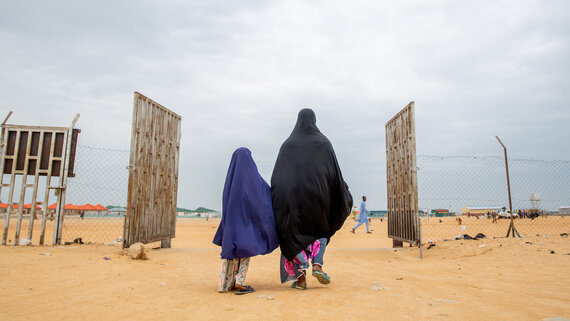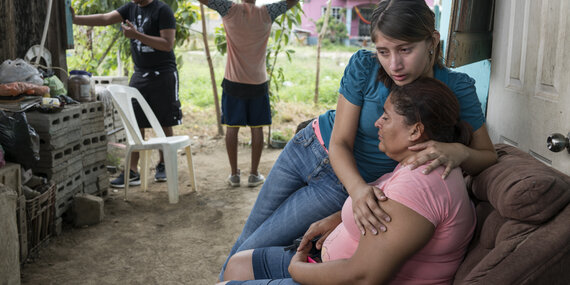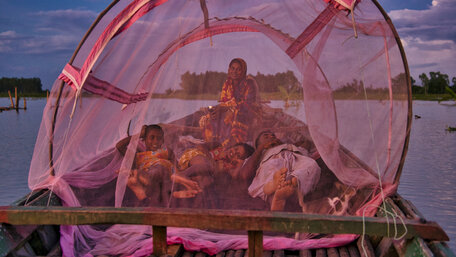El Progreso, Honduras
A mother is embraced by her daughter, in front of their home in El Progreso, Honduras. She has just found out the bank will take her home as she can no longer afford to pay her rent. In recent years, an increasing number of children and families from the Northern Triangle countries of Central America – El Salvador, Honduras and Guatemala – are migrating northwards through irregular pathways, hoping to resettle in the U.S. Some are fleeing pervasive gang violence in their home communities, while others are trying to escape endemic poverty. UNICEF/Bindra
Draft. Final version to be uploaded soon.
Protection must be central to the planning, programming, implementation and monitoring of humanitarian response. A shared responsibility to prioritise protection and contribute to collective protection outcomes is emphasised in IASC’s policy on Protection in humanitarian action (2016). The need to implement this commitment across the Humanitarian Programme Cycle is underlined, including in assessments, planning, programming, implementation and monitoring. Protection analysis and strategic protection objectives should inform and be reflected in all aspects of the HNO and HRP
Significant progress has been made following efforts in the development of joint analysis frameworks – such as the JIAF and the Protection Analytical Framework, developed through the Global Protection Cluster. Despite this, a number of critical areas still require more focus and investment including protection analysis, in particular ensuring a shared understanding and systematic collection of information and flow across sectors and actors. Better data collection and monitoring is also needed and greater articulation of practical references and outcomes that reduce risks to affected persons in response planning.
The Review of IASC Protection Policy Implementation and the UN Secretary-General’s Call to Action for Human Rights, can help foster collaboration and stimulate progress within the humanitarian system to address some of these areas. The Call to Action reiterates that human rights must be at the heart of all UN action, including in times of crises and it provides momentum to deepen and advance the centrality of protection in practice.

Bakassi, Nigeria
This woman fled the insurgency in Gwoza in 2016 right after her husband was killed as the insurgents stormed their village. She was pregnant at the time but managed to run away and was given shelter in Bakassi Camp, Maiduguri. Her daughter, Mariam, was born 40 days after the death of her husband. As a single mother, she managed to raise the child by herself for seven years until recently when a neighbor in the camp raped her daughter and then ran away. The police have been trying to find the perpetrator but without success. UNHCR, through their partner BOWDI, are helping the woman and her daughter and have provided psychosocial support, counselling and constant monitoring while working with law enforcement and legal teams who continue to seek justice for Mariam.
OCHA/Damilola OnafuwaIndependent Review of IASC Protection Policy Implementation
The IASC adopted a Policy on Protection in Humanitarian Action in 2016. This Policy was part of a concerted effort to address the most complex and severe risks of violence, coercion and deprivation. It provides the overarching framework for humanitarian actors to fulfill their responsibility to place protection at the center of humanitarian response, spelling out core principles, approaches, roles, and responsibilities. Since its introduction, some advances have been made. Nevertheless, challenges remain in implementing aspects of the Policy and in how to achieve protection outcomes collectively. Currently there is also insufficient investment in engagement with conflict parties to influence their attitudes and behaviors.
Against this background, the IASC agreed to review the implementation of the IASC Protection Policy. The Review is being conducted by an Overseas Development Institute (ODI) team under the leadership of former RC/HC Jamie McGoldrick, with financial support from Switzerland, Norway, Sweden and Canada. IASC Results Group 1 on Operational Response is guiding the review with the help of an Advisory Committee made up of senior experts from IASC organizations. The final report will include concrete recommendations on how the policy and specifically implementation can be improved and is expected in Spring 2022.
The priority protection issues of senior humanitarian leaders were outlined in a paper published by the Review Team in November 2021. These are not presented at conclusions but rather the basis for discussions in the next phase of the Review. The paper highlights eight priority areas: leadership, accountability, conceptualisation, the protection gap, protection architecture, results and impact, working with other actors on protection and localization.
Further reading
Source: IASC
Source: Global Protection Cluster
Source: United Nations





